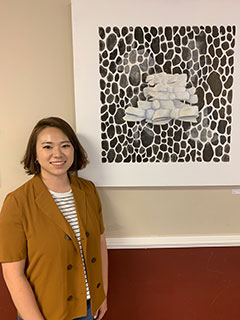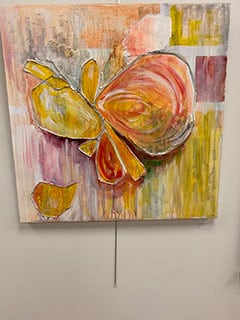
In 2015, Cindy witnessed something that would define her purpose as an artist. It was her sophomore year in college, and she was visiting family in Seoul when she met some of the country’s last surviving “Comfort Women.”
“Every Wednesday in front of Japanese Embassy in Seoul, these grandmothers would protest, asking the Japanese government to apologize and admit their fault. Many of the women were ill and couldn’t move easily, but they would come every Wednesday, and young adults would join them. That’s how I learned about the Comfort Women,” said Cindy.
In WWII, approximately 200,000 young women were trafficked and enslaved. Known as “Comfort Women”, many of these girls either were kidnapped from their families or willing left under the pretense of a well-paid job, only to be enslaved as sex workers for the Japanese Imperial Army. Many of these women died at the hands of their captors, while others have since deceased from old age and other causes. But 21 of these women are alive today and have shared their stories in hopes that it will never be forgotten.
Reading about the torture these women faced, Cindy’s discomfort escalated. Eventually, she decided to channel that emotion for her senior exit show and tell the story visually.
But recreating the Comfort Women’s tale was no easy task.

It was a stop and go process, but Cindy finally found a way to do the Comfort Women justice. To show their triumph in the face of torture as well as their resilience and hope, she decided to name her exhibit “Freedom Fighters”.
To Cindy, “The name ‘Freedom Fighters’ is including us in the story because they are a fighter, and we are not just going to stay silent about it. It’s sort of a label for them and us.”
As she came to that realization, Cindy decided to simplify the story and ‘bring out the women themselves’. “So, I started drawing and researching the women who passed away, and I wrote down what they said word-for-word.”

As a rule, Cindy’s style is abstract, although surreal is the best word to describe a piece she called “Butterfly”.
“The butterfly flies passed through the rigid grid, which symbolizes the kind of captivity they were under,” Cindy said of the 3D painting, which stands out as the most vibrant in the exhibit. Blended in red and yellow, it signifies the Freedom Fighter’s hope and courage. The butterfly is an icon of The Comfort Women as is the image of an empty chair.

On June 28, 2019, Cindy’s Freedom Fighter exhibit was displayed at an event held at the Korean American Association of Greater Atlanta in celebration of the statue’s second anniversary.
Showcased beside her work were paintings and drawings made by the last surviving Comfort Women who were able to tell their story through a visual medium during their art therapy session. That evening, those stories were brought to life through “A Stolen Girl’s Story: Opera” where performers put on a dramatic representation of the lives memorialized by the statue.
The “Freedom Fighters” exhibit was also displayed at the City of Sugar Hill earlier that same month. While her senior exit show included only six pieces, Cindy was able to add to the original exhibit, creating enough art to fill an entire room at City Hall.
Describing the exhibit, Cindy wrote, “This series portrays a broken yet triumphant story of Comfort Women and the people who fight for freedom every day.”
The UGA grad doesn’t have as much time to create, now that she’s a teacher, but she finds joy in exposing her students to art and helping them express what they feel looking at it.
She’ll never forget the day she realized why she wanted to teach. It was during a mission trip to Honduras where Cindy visited a house where a woman lived alone with her twin daughters, both of whom were deaf.

It was then that Cindy realized she wanted to teach and create and bring joy by shedding light on people and stories that would otherwise be forgotten.
“I think for me as an artist and as someone who loves kids, I realized what my purpose is as an artist,” Cindy said of her visit with the twins. “My art can create joy, and I realized it’s important for me to create and not just hold onto it. I chose to be a voice for the voiceless, and as I continue to create, I want to share their stories. The stories of the voiceless.”
When she’s not teaching elementary school, Cindy accepts commission work and creates as often as possible. More of her work can be seen online at cindyhongart.com and on Instagram: @Cindy.Hong.Art.

